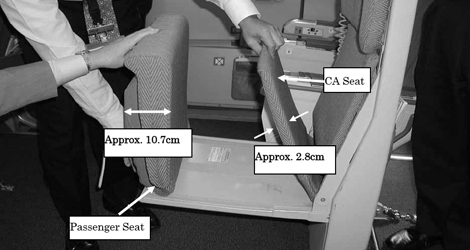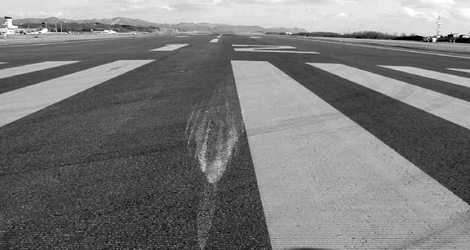ANA All Nippon Airways flight NH391 , an Airbus A321-131 registration JA104A, was operating as scheduled flight from Nagoya to Hakodate.
The flight crew of ANA All Nippon Airways flight NH391 were briefed for the flight by the dispatcher before departure from Nagoya Airport. The contents of the briefing relating to the weather at Hakodate Airport and its vicinity were as follows: Approach Procedure: ILS RWY 12, Ground Visibility: 5– 10km, Winds: strong, but no hindrance to landing.
The aircraft took off from Nagoya Airport at 11:53, and then, the aircraft thence proceeded to Hakodate Airport via Akita VOR/DME and Aomori VOR/DME. After beginning descent from cruise altitude, the aircraft was radar vectored onto the final approach course by the Hakodate Approach Control, and commenced an ILS Runway 12 approach at Hakodate Airport.
During the approach, the Captain assumed the duties of Pilot Not Flying (PNF) from the left cockpit seat, while the right-seated First Officer assumed Pilot Flying (PF) duties. The aircraft encountered light turbulence during the approach.
Hakodate Airport Tower reported the wind for runway 12 as 130°/28kt, a strong and slightly right crosswind. Although the approach course and flight path angle of aircraft were both normal during the approach, the aircraft’s wind shear warning system issued an aural wind shear warning at around 140 m from the runway threshold, at an altitude of 53 ft above ground level (AGL) while the aircraft was flying over the approach lights for runway 12.
Although the crew of ANA All Nippon Airways flight NH391 initiated a go-around to recover from the wind shear, the aircraft’s aft fuselage contacted the runway at around 13:03, and as a result substantial damage was sustained.
ANA All Nippon Airways flight NH391 continued to go around for recovery from the wind shear after contacted aft fuselage with the runway.
The crew made another ILS approach to runway 12, and landed at Hakodate Airport at around 13:21 uneventfully. An external check after arrival found that damage had been sustained to the lower surface of the aft fuselage. Of the 93 persons aboard ANA All Nippon Airways flight NH391 – 87 passengers and six crewmembers – three of the four cabin attendants sustained minor injuries such as bruising of the lower back etc.
In this accident, it is estimated that while on final approach at a height of approximately 100ft AGL, the aircraft encountered severe wind shear and although recovery actions were taken, a sufficient rate of ascent was not attained in time to prevent the lower surface of the aft fuselage striking the runway, resulting in damage to rear frames and the aft pressure bulkhead.

Cabin attendant vs. passenger seat : ANA All Nippon Airways flight NH391 – Airbus – A321-131 (JA-104A)
Although a vertical acceleration of approximately 1.9G occurred when the lower surface of the aft fuselage struck the ground, no injuries were sustained by the passengers or flight crew.
On the other hand, three of the four CAs sustained minor injuries such as lumber sprains, etc.
It is estimated that the reason that only CAs sustained minor injury is that the CA crew seats had inferior impact absorption characteristics, with the thickness of the cabin attendant seat cushions being less than one third that of the passenger seat cushions and the reclining angle of a CA seat was almost vertical with no armrest might be factors on this accident.
Further, the following factors are considered to have contributed to this accident:
- A delay in engine thrust response to the thrust levers being advanced to recover from the wind shear, combined with a reduced approach speed, meant that an increase in speed could not be obtained immediately. These factors contributed to the fact that sufficient rate of ascent could not be attained in time to prevent the tail strike.
- Factors contributing to the reduced approach speed were the fact that the first officer, acting as PF, had selected a slightly low value for the final approach speed, and that he reduced thrust in response to an increase in headwind.
- Factors in the reduction of engine thrust in response to the increase in headwind were that because the pilot was operating the thrust levers manually in “SELECTED SPEED” mode he was attempting to maintain a constant CAS, and that the flight crew had not adequately anticipated a increasing followed by a continuing drop in wind speed.
- Regarding the selection of a slightly low value for final approach speed, appropriate consideration was not given to wind speed, and there were concerns over touch down attitude related to high approach speeds.
- Regarding the fact that appropriate consideration was not given to wind speed, the first officer used a simple calculation formula that did not separately consider the additional airspeed margins to take account of wind speed changes and the head wind component, but that treated these together.
- Regarding the concerns over aircraft touch down attitude at high approach speeds, the measures described in the operator’s AOM for dealing with a nose-down attitude assumed only the case of full flap landings, and the First Officer considered difficulty to land an aircraft with a nose-down attitude.
It is considered possible that the low-level wind shear had originated due the effects of ground topography on the surface boundary layer under conditions of strong winds accompanied by gusts.
Download Report


0 Comments